seats MERCEDES-BENZ CLK CABRIOLET 2000 A208 Owner's Manual
[x] Cancel search | Manufacturer: MERCEDES-BENZ, Model Year: 2000, Model line: CLK CABRIOLET, Model: MERCEDES-BENZ CLK CABRIOLET 2000 A208Pages: 323, PDF Size: 9.32 MB
Page 3 of 323

IntroductionCentral locking switch 36 Antiglare night position 75
Product information 7 Automatic central locking 37 Exterior rear view mirrors 76
Operator’s manual 8 Emergency unlocking in case of accident 38 Instrument cluster 80
Where to find it 13 Trunk 39 Multifunction steering wheel,
Reporting Safety Defects 15 Trunk lid release switch 41multifunction display
86
Antitheft alarm system 42 Trip and main odometer, vehicle
Instruments and controlsTow-away alarm 44 speed, FSS and engine oil level
Instruments and controls 18 Power seats, front 45 indicator 90
Center console 20 Front head restraints 50 Audio systems 91
Overhead control panel 21 Roll bar and head restraints, rear 51 Telephone 94
Backrest 53 Navigation system 99
OperationMulticontour seat 54 Trip computer 100
Vehicle keys 24 Heated seats 55 Malfunction message memory 102
Start lock-out 27 Seat belts and integrated restraint system 57 Individual settings 104
General notes on the central
locking system 27Seat belts 57 Setting the audio volume 106
Central locking system 28 Seat belt nonusage warning system 58 Flexible service system (FSS) 107
Radio frequency and infrared
remote control 28BabySmart™ airbag deactivation system 63 Engine oil level indicator 110
Locking and unlocking 30 Supplemental restraint system (SRS) 64 Engine oil consumption 111
Choosing global or selective mode
on remote control 31Emergency tensioning retractor (ETR) 64 Exterior lamp switch 112
Opening the trunk 31 Airbags 65 Night security illumination 113
Opening and closing windows
from outside 32Safety guidelines for the seat belt,
emergency tensioning retractor and airbag 70Headlamp cleaning system 114
Panic button 33 Infant and child restraint systems 71 Combination switch 115
Mechanical keys 33 Adjusting telescoping steering column 74 Hazard warning flasher switch 117
Doors 34 Inside rear view mirror 75 Automatic climate control 118
3
Page 22 of 323

OperationPower seats, front 45
Front head restraints 50
Vehicle keys 24 Roll bar and head restraints, rear 51
Start lock-out 27 Backrest 53
General notes on the central locking system 27 Multicontour seat 54
Central locking system 28 Heated seats 55
Radio frequency and infrared remote control 28 Seat belts and integrated restraint system 57
Locking and unlocking 30 Seat belts 57
Choosing global or selective mode on remote control 31 Seat belt nonusage warning system 58
Opening the trunk 31 BabySmart™ airbag deactivation system 63
Opening and closing windows from outside 32 Supplemental restraint system (SRS) 64
Panic button 33 Emergency tensioning retractor (ETR) 64
Mechanical keys 33 Airbags 65
Doors 34 Safety guidelines for the seat belt, emergency
tensioning retractor and airbag 70
Central locking switch 36 Infant and child restraint systems 71
Automatic central locking 37 Adjusting telescoping steering column 74
Emergency unlocking in case of accident 38 Inside rear view mirror 75
Trunk 39 Antiglare night position 75
Trunk lid release switch 41 Exterior rear view mirrors 76
Antitheft alarm system 42 Instrument cluster 80
Tow-away alarm 44
22
Page 45 of 323
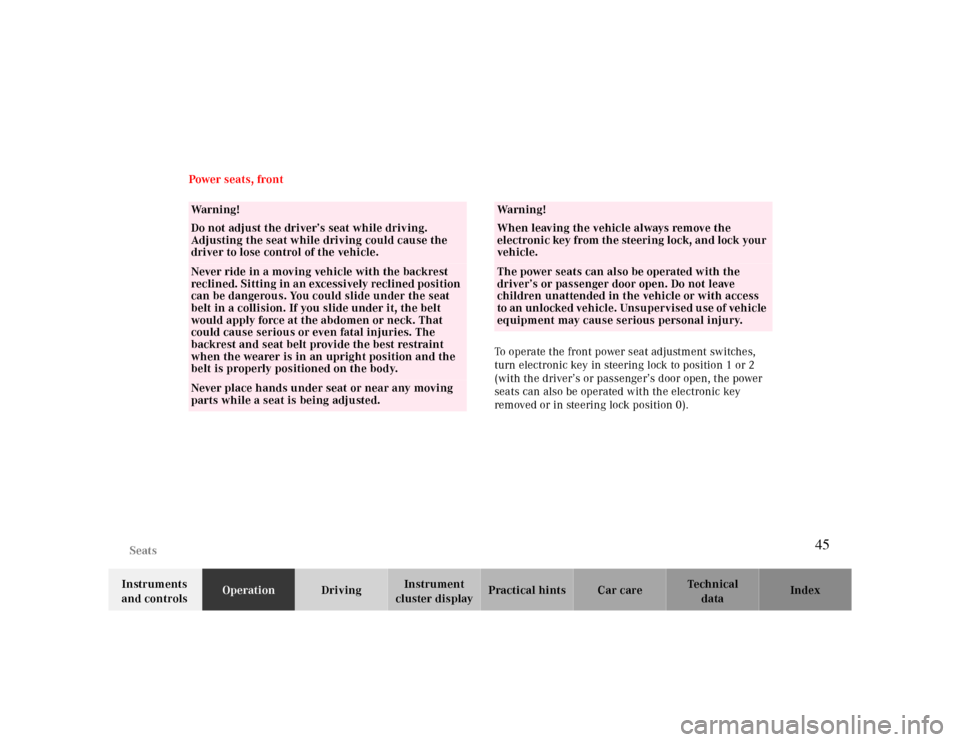
Seats
Te ch n ica l
data Instruments
and controlsOperationDrivingInstrument
cluster displayPractical hints Car care Index Power seats, front
To operate the front power seat adjustment switches,
turn electronic key in steering lock to position 1 or 2
(with the driver’s or passenger’s door open, the power
seats can also be operated with the electronic key
removed or in steering lock position 0).
Warning!
Do not adjust the driver’s seat while driving.
Adjusting the seat while driving could cause the
driver to lose control of the vehicle.Never ride in a moving vehicle with the backrest
reclined. Sitting in an excessively reclined position
can be dangerous. You could slide under the seat
belt in a collision. If you slide under it, the belt
would apply force at the abdomen or neck. That
could cause serious or even fatal injuries. The
backrest and seat belt provide the best restraint
when the wearer is in an upright position and the
belt is properly positioned on the body.Never place hands under seat or near any moving
parts while a seat is being adjusted.
Wa r n i n g !
When leaving the vehicle always remove the
electronic key from the steering lock, and lock your
vehicle.The power seats can also be operated with the
driver’s or passenger door open. Do not leave
children unattended in the vehicle or with access
to an unlocked vehicle. Unsupervised use of vehicle
equipment may cause serious personal injury.
45
Page 46 of 323
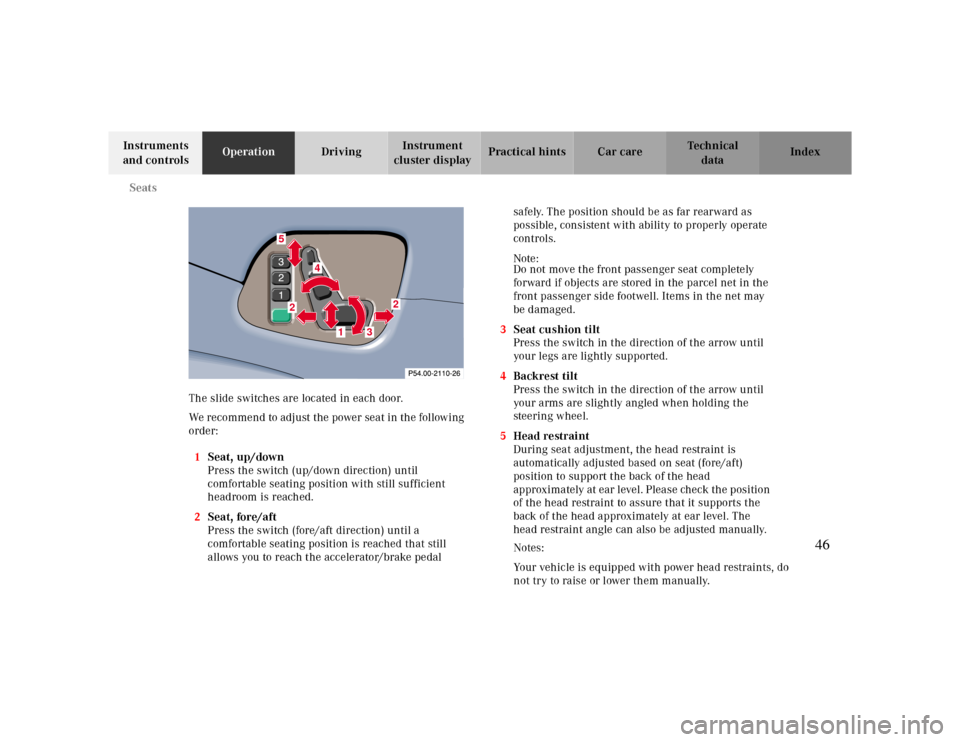
Seats
Te ch n ica l
data Instruments
and controlsOperationDrivingInstrument
cluster displayPractical hints Car care Index
The slide switches are located in each door.
We recommend to adjust the power seat in the following
order:
1Seat, up/down
Press the switch (up/down direction) until
comfortable seating position with still sufficient
headroom is reached.
2Seat, fore/aft
Press the switch (fore/aft direction) until a
comfortable seating position is reached that still
allows you to reach the accelerator/brake pedal safely. The position should be as far rearward as
possible, consistent with ability to properly operate
controls.
Note:
Do not move the front passenger seat completely
forward if objects are stored in the parcel net in the
front passenger side footwell. Items in the net may
be damaged.
3Seat cushion tilt
Press the switch in the direction of the arrow until
your legs are lightly supported.
4Backrest tilt
Press the switch in the direction of the arrow until
your arms are slightly angled when holding the
steering wheel.
5Head restraint
During seat adjustment, the head restraint is
automatically adjusted based on seat (fore/aft)
position to support the back of the head
approximately at ear level. Please check the position
of the head restraint to assure that it supports the
back of the head approximately at ear level. The
head restraint angle can also be adjusted manually.
87
4
52
2
1
3
Notes:
Your vehicle is equipped with power head restraints, do
not try to raise or lower them manually.
46
Page 47 of 323
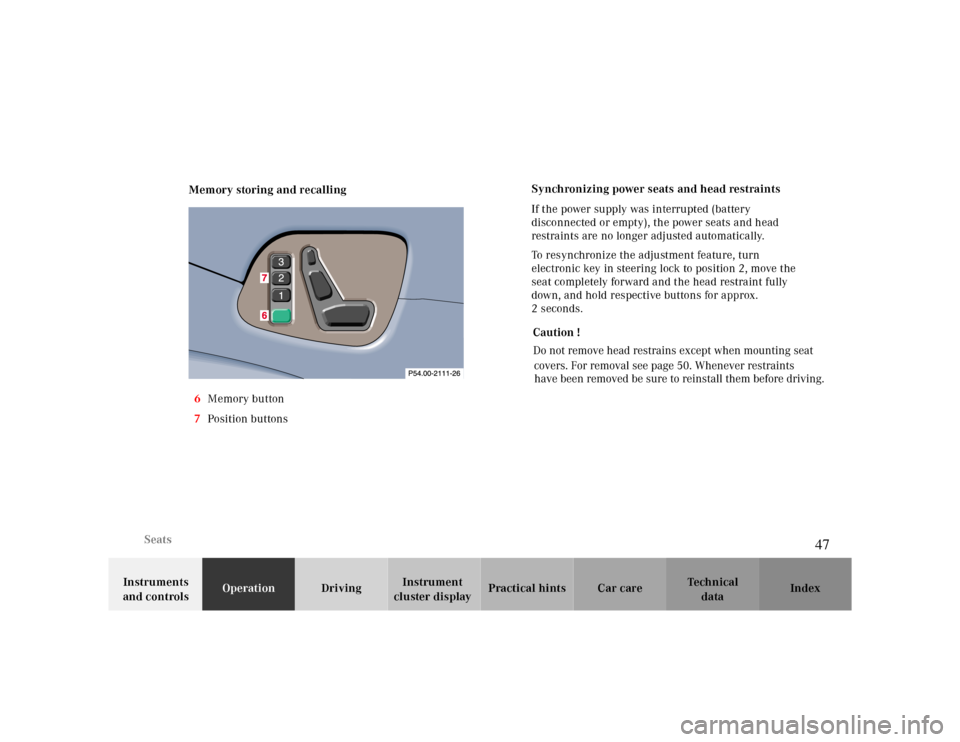
Seats
Te ch n ica l
data Instruments
and controlsOperationDrivingInstrument
cluster displayPractical hints Car care Index Memory storing and recalling
6Memory button
7Position buttons
Synchronizing power seats and head restraints
If the power supply was interrupted (battery
disconnected or empty), the power seats and head
restraints are no longer adjusted automatically.
To resynchronize the adjustment feature, turn
electronic key in steering lock to position 2, move the
seat completely forward and the head restraint fully
down, and hold respective buttons for approx.
2seconds.
Caution !
Do not remove head restrains except when mounting seat
covers. For removal see page 50. Whenever restraints
have been removed be sure to reinstall them before driving.
47
Page 48 of 323
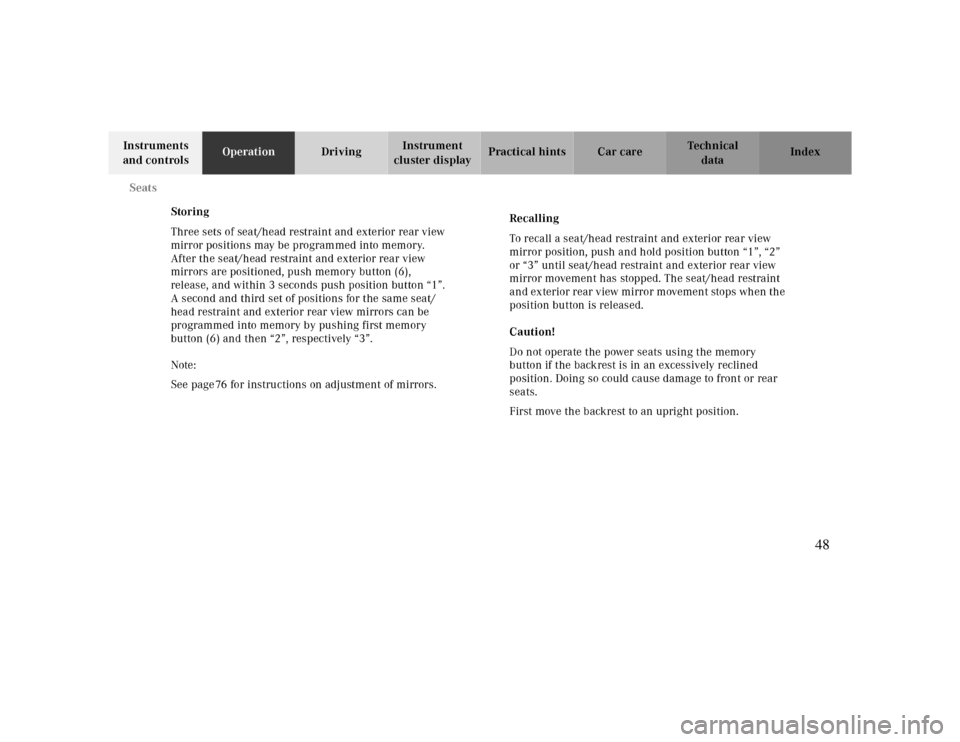
Seats
Te ch n ica l
data Instruments
and controlsOperationDrivingInstrument
cluster displayPractical hints Car care Index
Storing
Three sets of seat/head restraint and exterior rear view
mirror positions may be programmed into memory.
After the seat/head restraint and exterior rear view
mirrors are positioned, push memory button (6),
release, and within 3 seconds push position button “1”.
A second and third set of positions for the same seat/
head restraint and exterior rear view mirrors can be
programmed into memory by pushing first memory
button (6) and then “2”, respectively “3”.
Note:
See page
76
for instructions on adjustment of mirrors.Recalling
To recall a seat/head restraint and exterior rear view
mirror position, push and hold position button “1”, “2”
or “3” until seat/head restraint and exterior rear view
mirror movement has stopped. The seat/head restraint
and exterior rear view mirror movement stops when the
position button is released.
Caution!
Do not operate the power seats using the memory
button if the backrest is in an excessively reclined
position. Doing so could cause damage to front or rear
seats.
First move the backrest to an upright position.
48
Page 49 of 323
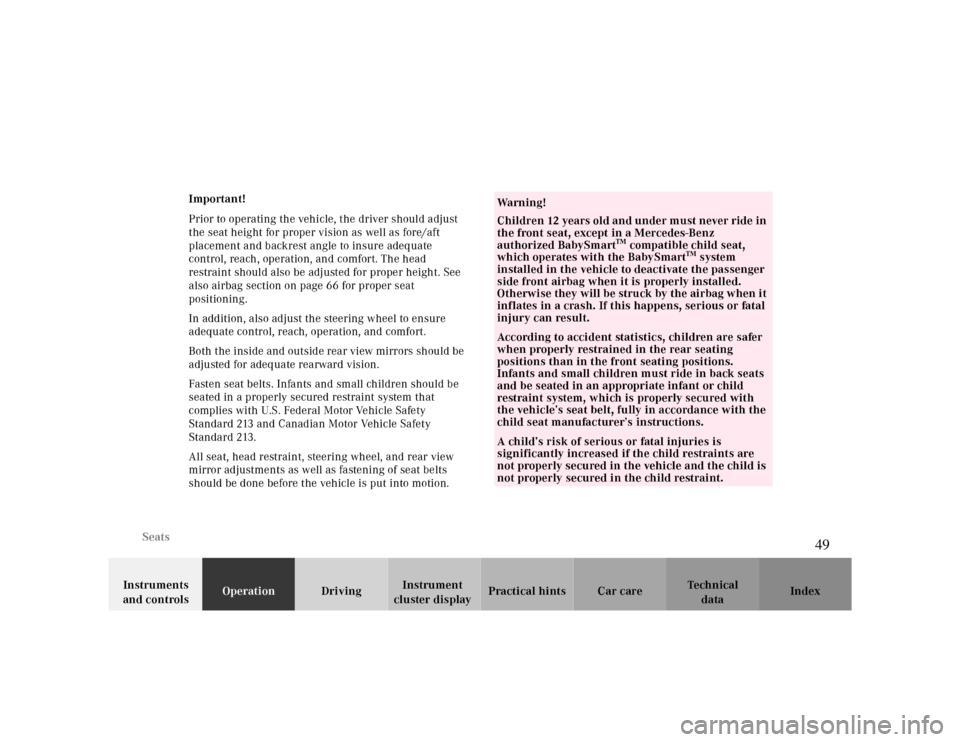
Seats
Te ch n ica l
data Instruments
and controlsOperationDrivingInstrument
cluster displayPractical hints Car care Index Important!
Prior to operating the vehicle, the driver should adjust
the seat height for proper vision as well as fore/aft
placement and backrest angle to insure adequate
control, reach, operation, and comfort. The head
restraint should also be adjusted for proper height. See
also airbag section on page 66 for proper seat
positioning.
In addition, also adjust the steering wheel to ensure
adequate control, reach, operation, and comfort.
Both the inside and outside rear view mirrors should be
adjusted for adequate rearward vision.
Fasten seat belts. Infants and small children should be
seated in a properly secured restraint system that
complies with U.S. Federal Motor Vehicle Safety
Standard 213 and Canadian Motor Vehicle Safety
Standard 213.
All seat, head restraint, steering wheel, and rear view
mirror adjustments as well as fastening of seat belts
should be done before the vehicle is put into motion.
Wa r n i n g !
Children 12 years old and under must never ride in
the front seat, except in a Mercedes-Benz
authorized BabySmart
TM compatible child seat,
which operates with the BabySmart
TM system
installed in the vehicle to deactivate the passenger
side front airbag when it is properly installed.
Otherwise they will be struck by the airbag when it
inflates in a crash. If this happens, serious or fatal
injury can result.
According to accident statistics, children are safer
when properly restrained in the rear seating
positions than in the front seating positions.
Infants and small children must ride in back seats
and be seated in an appropriate infant or child
restraint system, which is properly secured with
the vehicle’s seat belt, fully in accordance with the
child seat manufacturer’s instructions.A child’s risk of serious or fatal injuries is
significantly increased if the child restraints are
not properly secured in the vehicle and the child is
not properly secured in the child restraint.
49
Page 50 of 323
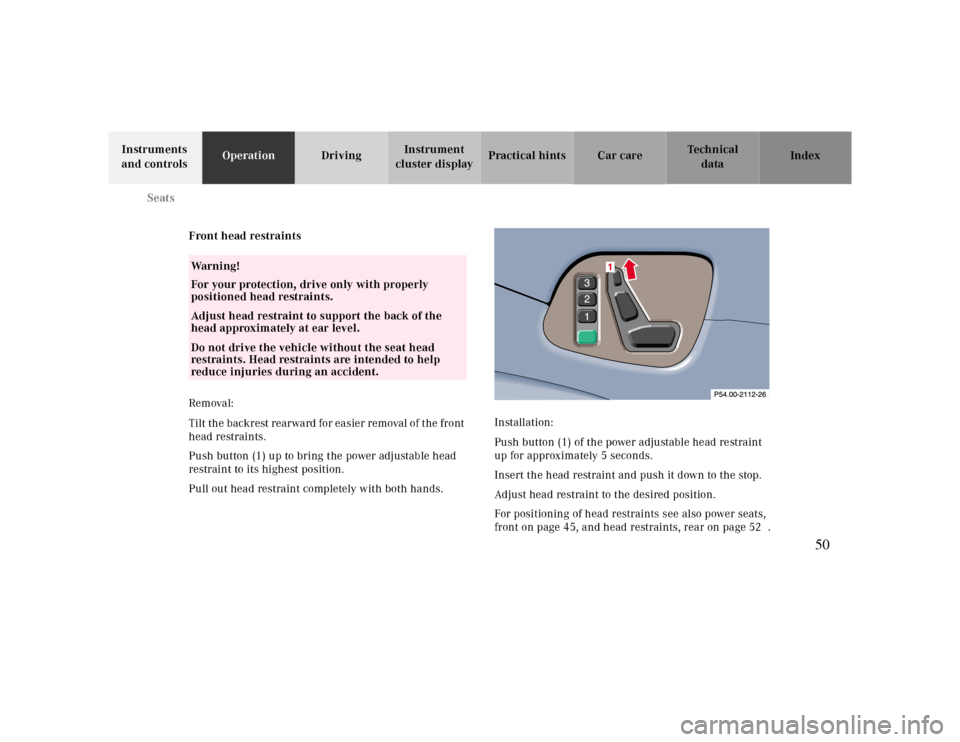
Seats
Te ch n ica l
data Instruments
and controlsOperationDrivingInstrument
cluster displayPractical hints Car care Index
Front head restraints
Removal:
Tilt the backrest rearward for easier removal of the front
head restraints.
Push button (1) up to bring the power adjustable head
restraint to its highest position.
Pull out head restraint completely with both hands.Installation:
Push button (1) of the power adjustable head restraint
up for approximately 5 seconds.
Insert the head restraint and push it down to the stop.
Adjust head restraint to the desired position.
For positioning of head restraints see also power seats,
front on page 45, and head restraints, rear on page 52.
Warning!
For your protection, drive only with properly
positioned head restraints.Adjust head restraint to support the back of the
head approximately at ear level.Do not drive the vehicle without the seat head
restraints. Head restraints are intended to help
reduce injuries during an accident.
50
Page 51 of 323
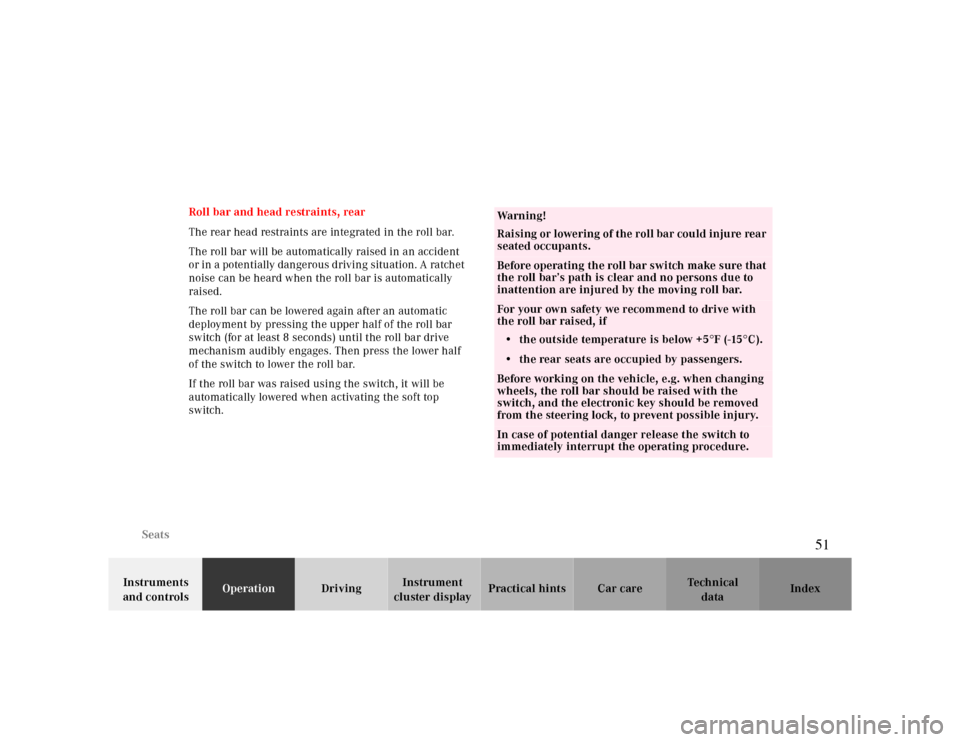
Seats
Te ch n ica l
data Instruments
and controlsOperationDrivingInstrument
cluster displayPractical hints Car care Index Roll bar and head restraints, rear
The rear head restraints are integrated in the roll bar.
The roll bar will be automatically raised in an accident
or in a potentially dangerous driving situation. A ratchet
noise can be heard when the roll bar is automatically
raised.
The roll bar can be lowered again after an automatic
deployment by pressing the upper half of the roll bar
switch (for at least 8 seconds) until the roll bar drive
mechanism audibly engages. Then press the lower half
of the switch to lower the roll bar.
If the roll bar was raised using the switch, it will be
automatically lowered when activating the soft top
switch.
Wa r n i n g !
Raising or lowering of the roll bar could injure rear
seated occupants. Before operating the roll bar switch make sure that
the roll bar’s path is clear and no persons due to
inattention are injured by the moving roll bar. For your own safety we recommend to drive with
the roll bar raised, if
• the outside temperature is below +5°F (-15°C).
• the rear seats are occupied by passengers. Before working on the vehicle, e.g. when changing
wheels, the roll bar should be raised with the
switch, and the electronic key should be removed
from the steering lock, to prevent possible injury. In case of potential danger release the switch to
immediately interrupt the operating procedure.
51
Page 52 of 323
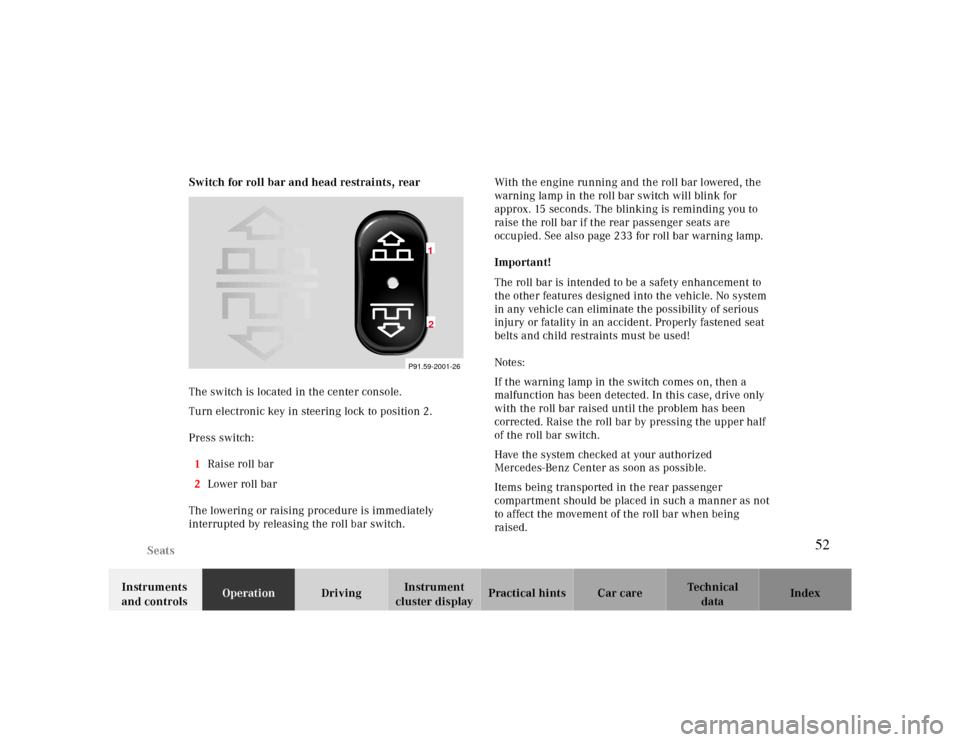
Seats
Te ch n ica l
data Instruments
and controlsOperationDrivingInstrument
cluster displayPractical hints Car care Index Switch for roll bar and head restraints, rear
The switch is located in the center console.
Turn electronic key in steering lock to position 2.
Press switch:
1Raise roll bar
2Lower roll bar
The lowering or raising procedure is immediately
interrupted by releasing the roll bar switch. With the engine running and the roll bar lowered, the
warning lamp in the roll bar switch will blink for
approx. 15 seconds. The blinking is reminding you to
raise the roll bar if the rear passenger seats are
occupied. See also page 233 for roll bar warning lamp.
Important!
The roll bar is intended to be a safety enhancement to
the other features designed into the vehicle. No system
in any vehicle can eliminate the possibility of serious
injury or fatality in an accident. Properly fastened seat
belts and child restraints must be used!
Notes:
If the warning lamp in the switch comes on, then a
malfunction has been detected. In this case, drive only
with the roll bar raised until the problem has been
corrected. Raise the roll bar by pressing the upper half
of the roll bar switch.
Have the system checked at your authorized
Mercedes-Benz Center as soon as possible.
Items being transported in the rear passenger
compartment should be placed in such a manner as not
to affect the movement of the roll bar when being
raised.
P91.59-2001-26
12
52